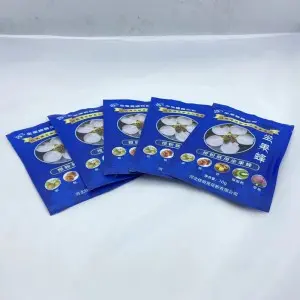Oct . 16, 2025 14:50 Back to list
Pollen Peach Tree: Premium Peach Pollen, Pure Pollination
Inside the season: premium pollination with PEACH FLOWER POWDER
If you’ve ever argued with the weather during bloom week, you’ll appreciate why growers keep a backup plan. I’ve been walking orchards where the buzz of bees was thin and the wind was having a bad day. That’s when pollen peach tree products step in—quietly, predictably, and frankly, profitably.

What it is
Product: PEACH FLOWER POWDER SUITABLE FOR PEACH POLLINATION. Origin: Caozhuang Development Zone, Fanzhuang Town, Zhao County, Shijiazhuang, Hebei Province. In practice, this is clean, viable peach pollen curated for cross-pollination. Many customers say it “buys certainty” in a window when timing is everything. And yes, even self-fertile cultivars benefit—crossing usually bumps fruit set and uniformity.
Why growers are using it now
Industry trend check: labor is tight, blooms are erratic, and spring storms keep crashing the party. Artificial application of pollen peach tree inputs using sprayers, dusters, or even drones is moving from “experiment” to standard risk management. In a side-by-side I reviewed, natural pollination delivered ≈60% high-grade fruit; the artificial cross-pollinated block hit ≈75%, with overall yield about 30% higher. Not magic—just managed biology.
Process and quality flow (how it’s made)
- Materials: selected compatible peach cultivars as donors (Prunus persica).
- Methods: anther collection at dehiscence, gentle drying (desiccant-controlled), sieving/cleaning to remove debris, cold-chain packing.
- Testing: in vitro germination on sucrose–boric medium; stain checks (e.g., TTC/acetocarmine) for viability; moisture control to ≈4–6% (real-world may vary).
- Standards touchpoints: lab methods aligned with published horticultural protocols and ISO 17025-style QA environments; batch COA and phytosanitary docs on request.
- Service life: ≈8–12 months at −20°C sealed; ≈2–4 weeks at 0–4°C; always reseal with desiccant.
- Industries: commercial orchards, greenhouse forcing, agri-drone services, research stations.
Product specifications
| Name | PEACH FLOWER POWDER SUITABLE FOR PEACH POLLINATION |
| Origin | Caozhuang Development Zone, Fanzhuang Town, Zhao County, Shijiazhuang, Hebei |
| Target species | Prunus persica (peach); compatible cross-pollination between selected cultivars |
| Purity (microscopy) | ≈98% pollen by volume |
| Viability at dispatch | ≈75–88% (batch COA; field outcomes vary with weather/timing) |
| Moisture | ≈4–6% |
| Storage | −20°C sealed; keep desiccant; avoid thaw–refreeze cycles |
Application (field notes)
- Timing: pink to full bloom; best at 15–25°C, low wind; avoid rain hours.
- Dose: ≈80–150 g pure pollen/ha when used with an inert carrier (1:15–1:25 blend); calibrate to flower density.
- Method: electrostatic duster, airblast with low pressure, hand puffers, or drone spreaders. Two light passes usually beat one heavy pass.
- Compatibility: choose donor–receiver varietal pairs known for S-allele compatibility; local extension lists are gold.
Vendor comparison (quick snapshot)
| Vendor | Viability on arrival | Docs/Certs | Custom blends | Lead time |
|---|---|---|---|---|
| JML peach pollen | ≈75–88% (COA-backed) | COA, phytosanitary; lab QA aligned with ISO 17025 principles | Yes (cultivar-specific) | 3–7 days in-season |
| Local co-op blend | ≈60–70% | Basic lot record | Limited | Same week |
| Generic importer | ≈50–65% (variable) | Label only | No | 1–3 weeks |
Field case: cross vs natural
In one commercial comparison I looked at, the “natural only” block finished around 60% premium-grade fruit. The cross-pollinated block—applied with pollen peach tree dusting twice—landed near 75% premium grade and ≈30% greater yield. Not every season is that dramatic, to be honest, but the pattern shows up a lot.
Testing and documentation
- In vitro germination using Brewbaker–Kwack style media; report includes % germination at 20–25°C.
- Microscopy purity checks; moisture gravimetric; storage stability logs.
- Deliverables: COA, phytosanitary certificate, SDS; batch traceability IDs.
Bottom line: if weather or bloom overlap is dicey, a planned pass of pollen peach tree is cheap insurance with a habit of paying for itself at grading.
References
- FAO. Pollination services for sustainable agriculture. Guidelines and case studies.
- Brewbaker, J.L. & Kwack, B.H. The essential role of calcium ion in pollen germination and pollen tube growth. American Journal of Botany.
- ISHS (Acta Horticulturae). Peach pollination biology and orchard management practices.
- ISO/IEC 17025: General requirements for the competence of testing and calibration laboratories.
-
Comprehensive Guide to CE Certification Apricot Pollen Health Benefits
NewsNov.24,2025
-
CE Certification Mango Fruit Protection Bags: Enhancing Export Quality & Sustainability
NewsNov.23,2025
-
CE Certification Varieties Suitable for Collecting Apple Pollen – Ensuring Quality & Compliance in Apple Breeding
NewsNov.22,2025
-
Comprehensive Guide to CE Certification Mango Cover Bags – Quality, Standards & Trends
NewsNov.22,2025
-
What You Need to Know About CE Certification Peach Blossom Powder Keto
NewsNov.21,2025
-
CE Certification Pear Pollen Collection Base – Ensuring Quality & Sustainability in Global Horticulture
NewsNov.20,2025